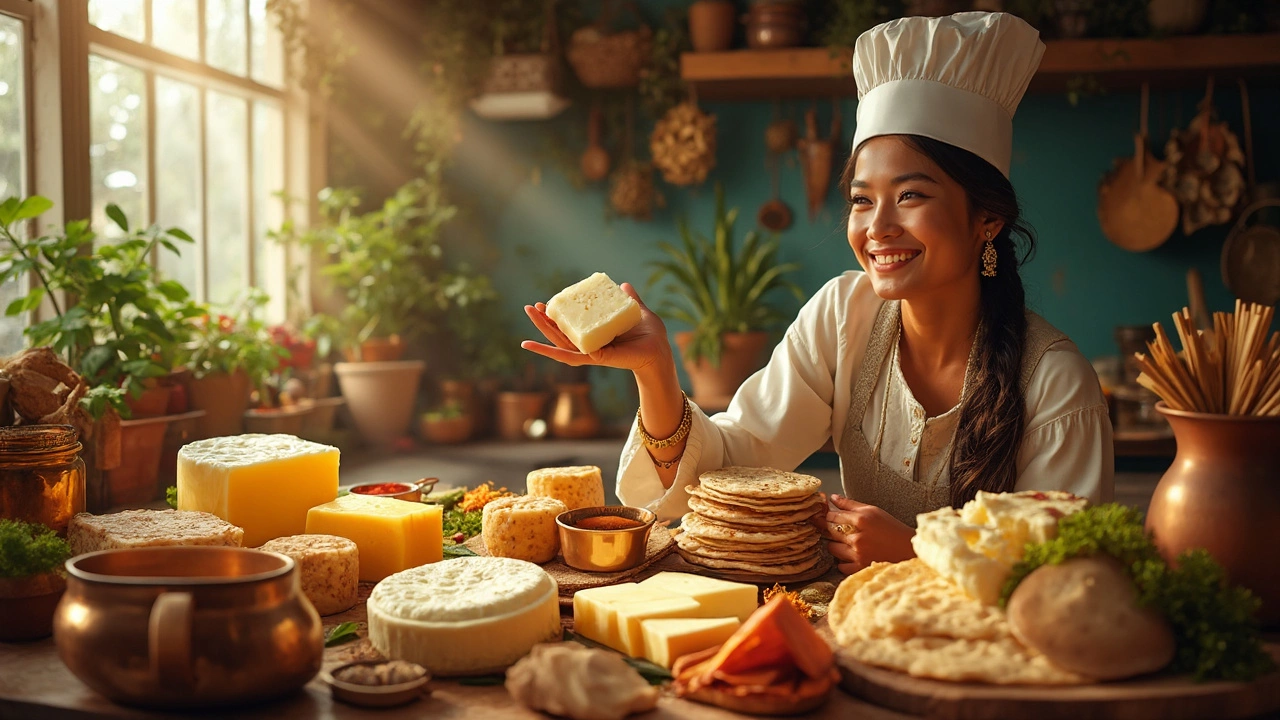English Cheese: Flavors, Types, and Cooking Tips
When exploring English cheese, a diverse group of cheeses from England known for distinct textures, flavors, and aging traditions. Also known as British cheese, it offers everything from crumbly farmhouse varieties to smooth, melt‑ready blocks. Understanding its basics helps you pick the right cheese for a sandwich, a cheese board, or a hot curry. Below we’ll break down the most popular styles and show how they fit into everyday meals.
Key Varieties and Their Core Traits
One of the flagship styles is Cheddar, a sharp, aged cheese from Somerset that ranges from mild to extra‑sharp depending on maturation time. Cheddar’s firm texture makes it perfect for grilling, shredding into pasta, or crumbling over salads. Another iconic name is Stilton, the blue‑veined cheese from the Midlands, famous for its creamy crumb and pungent note. Stilton shines on cheese platters, paired with honey, or mixed into rich sauces. Both cheeses illustrate how English cheese spans from everyday cooking staples to premium tasting experiences.
Beyond these, there are milder options like Red Leicester and crumbly cheeses such as Wensleydale. Each brings its own grainy texture and buttery flavor. When you know the main attributes—sharpness, aging period, moisture level—you can match the cheese to the right dish without guessing. This knowledge also links directly to the Indian cooking world, where paneer serves as a neutral canvas, yet many Indian chefs now experiment with English cheeses to add depth.
Speaking of Indian cheese, Paneer, a fresh, non‑aged cheese made from curdled milk, widely used in North Indian cuisine shares some processing steps with English cheese, especially when it comes to curd formation. While paneer stays soft and never ages, its texture can be enhanced by brief marination with aged English cheeses, creating fusion dishes like Cheddar‑paneer tikka. This crossover shows how understanding English cheese can expand your culinary toolkit, whether you’re cooking a classic British pie or a modern Indo‑British snack.
Choosing the right cheese also depends on pairing principles. Cheese pairing, the art of matching cheese with wines, fruits, breads, or spices to highlight complementary flavors is a skill that translates to Indian meals. Sharp Cheddar balances sweet mango chutney, while creamy Stilton pairs well with spiced figs or a drizzle of jaggery‑infused mustard. By treating English cheese as a flavor bridge, you can design plates that satisfy both Western palates and Indian taste buds.
From a practical standpoint, handling English cheese correctly maximizes its potential. For hard cheeses like mature Cheddar, storing them in a cheese paper or a loosely sealed container keeps the crust from drying out while allowing it to breathe. Soft cheeses like Stilton need a cooler, humidity‑controlled space to preserve the blue veins. Knowing these storage basics prevents waste and ensures you always have a piece ready for that impromptu snack or recipe.
Cooking techniques vary by cheese type. When melting, opt for younger Cheddar or a mild English cheese to achieve a smooth stretch without graininess. For baked dishes, aged Cheddar adds a deep umami note, while Stilblue crumbles create a striking visual contrast in casseroles. Incorporating English cheese into Indian dishes follows similar logic: add shredded Cheddar to a baked bhaji for a crisp topping, or fold crumbled Stilton into a spinach dal for a luxurious finish.
Health considerations matter too. English cheese provides calcium, protein, and vitamin B12, but the fat content can differ widely. Choosing lower‑fat options like reduced‑fat Cheddar helps keep dishes lighter, while still delivering that characteristic bite. Pairing cheese with fiber‑rich sides—whole‑grain roti, lentil salads, or roasted vegetables—creates balanced meals that satisfy cravings without overloading on calories.
All this background sets the stage for the articles below. You’ll find deep dives into why soda helps dosa batter, how to master the perfect chicken marinade, and even tricks for softening paneer. Each piece touches on a concept we’ve discussed—whether it’s fermentation, texture control, or flavor pairing—showing how English cheese knowledge threads through a wide range of cooking topics. Dive in and see how the ideas connect to boost your kitchen confidence.

English Equivalent of Paneer: What’s the Closest Cheese?
Wondering what the English equivalent of paneer is? This guide breaks down how paneer compares to Western cheeses, how you can substitute or make it at home, and what sets it apart in flavor and texture. You’ll also get tips for using paneer in everyday cooking and bust a few myths about cheese swaps. Perfect if you’re curious about Indian food or looking to experiment in your own kitchen. Get the know-how to impress at your next dinner party.
- Chutney Recipes (13)
- General (11)
- Healthy Living (10)
- Easy Indian Recipes (9)
- Chicken Curry Recipes (9)
- Healthy Indian Snacks (8)
- Paneer Recipes (7)
- Dal Recipes (7)
- Street Food (7)
- Dosa Recipes (7)
-
Substituting Tandoori Masala: Spice Mix for Tandoori Chicken Lovers
28 Mar 2025 -
Most Selling Street Fast Food in India: Top Picks You Can't Miss
21 Jun 2025 -
How to Take the Bitterness Out of Chutney: Easy Tricks That Work
23 Apr 2025 -
Famous Vegetarian Foods of India: Culinary Icons, Regional Favorites, and Must-Try Dishes
11 Jul 2025 -
Why Add Soda to Dosa Batter? Benefits, Ratios & Tips
17 Oct 2025
17.05.25
Kaia Binari
0